Effect of Mo and Cr on S-Induced Intergranular Fracture in γ-Fe
Abstract
:1. Introduction
2. Computational Methods and Model
3. Results and Discussion
4. Conclusions
- S tends to segregate in Σ5(210), Σ5(310), and Σ9(114) GBs. The segregation tendency of sulfur at the Σ5(210) GB is stronger than that at the two other grain boundaries. With increasing S atom numbers at the Σ5 (210) GB, the lattice distortion of the GB position leads to increasing interlayer spacing in the interface region, until the interface cracks.
- Mo or Cr in the GB has a certain inhibitory effect on S-induced intergranular fracture, and the effect of Mo is stronger than that of Cr. The combination of Mo and Cr more obviously inhibits the influence of S inside the GB. Mo and Cr can strengthen the bonding ability of GBs. These findings are helpful for understanding how S-induced intergranular fracture in Fcc-Fe is determined using Cr and Mo-segregation GBs in high-Mo austenitic stainless steel.
Author Contributions
Funding
Data Availability Statement
Conflicts of Interest
References
- Lo, K.H.; Shek, C.H.; Lai, J.K.L. Recent developments in stainless steels. Mater. Sci. Eng. R Rep. 2009, 65, 39–104. [Google Scholar] [CrossRef]
- Zhang, S.; Li, H.; Jiang, Z.; Li, Z.; Wu, J.; Zhang, B.; Duan, F.; Feng, H.; Zhu, H. Influence of N on precipitation behavior, associated corrosion and mechanical properties of super austenitic stainless steel S32654. J. Mater. Sci. Technol. 2020, 42, 143–155. [Google Scholar] [CrossRef]
- Zhang, S.; Yu, J.; Li, H.; Jiang, Z.; Geng, Y.; Feng, H.; Zhang, B.; Zhu, H. Refinement mechanism of cerium addition on solidification structure and sigma phase of super austenitic stainless steel S32654. J. Mater. Sci. Technol. 2022, 102, 105–114. [Google Scholar] [CrossRef]
- Willenbruch, R.D.; Clayton, C.R.; Oversluizen, M.; Kim, D.; Lu, Y. An XPS and electrochemical study of the influence of molybdenum and nitrogen on the passivity of austenitic stainless steel. Corros. Sci. 1990, 31, 179–190. [Google Scholar] [CrossRef]
- Zhang, S.; Li, H.; Jiang, Z.; Zhang, B.; Li, Z.; Wu, J.; Fan, S.; Feng, H.; Zhu, H. Effects of Cr and Mo on precipitation behavior and associated intergranular corrosion susceptibility of superaustenitic stainless steel S32654. Mater. Charact. 2019, 152, 141–150. [Google Scholar] [CrossRef]
- Shoemaker, L.E.; Crum, J.R. Experience in Effective Application of Metallic Materials for Construction of FGD Systems; Special Metals Corporation: New Hartford, NY, USA, 2010. [Google Scholar]
- Herda, W.; Rockel, M.; Grossmann, G.; Starke, K. High specialty stainless steels and nickel alloys for FGD dampers. In Proceedings of the Corrosion97, New Orleans, LA, USA, 9–14 March 1997. [Google Scholar]
- Liu, T.; Xia, S.; Bai, Q.; Zhou, B.; Zhang, L.; Lu, Y.; Shoji, T. Three-dimensional study of grain boundary engineering effects on intergranular stress corrosion cracking of 316 stainless steel in high temperature water. J. Nucl. Mater. 2018, 498, 290–299. [Google Scholar] [CrossRef]
- Gesari, S.B.; Pronsato, M.E.; Juan, A. The electronic structure and bonding of H pairs at Σ= 5 BCC Fe grain boundary. Appl. Surf. Sci. 2002, 187, 207–217. [Google Scholar] [CrossRef]
- Di Stefano, D.; Mrovec, M.; Elsässer, C. First-principles investigation of hydrogen trapping and diffusion at grain boundaries in nickel. Acta Mater. 2015, 98, 306–312. [Google Scholar] [CrossRef]
- Kart, H.H.; Uludogan, M.; Cagin, T. DFT studies of sulfur induced stress corrosion cracking in nickel. Comput. Mater. Sci. 2009, 44, 1236–1242. [Google Scholar] [CrossRef]
- Pardo, A.; Merino, M.C.; Coy, A.E.; Viejo, F.; Arrabal, R.; Matykina, E. Pitting corrosion behaviour of austenitic stainless steels–combining effects of Mn and Mo additions. Corros. Sci. 2008, 50, 1796–1806. [Google Scholar] [CrossRef]
- Kaneko, M.; Isaacs, H.S. Effects of molybdenum on the pitting of ferritic-and austenitic-stainless steels in bromide and chloride solutions. Corros. Sci. 2002, 44, 1825–1834. [Google Scholar] [CrossRef]
- Ameer, M.A.; Fekry, A.M.; Heakal, F.E. Electrochemical behaviour of passive films on molybdenum-containing austenitic stainless steels in aqueous solutions. Electrochim. Acta 2004, 50, 43–49. [Google Scholar] [CrossRef]
- Tobler, W.J.; Virtanen, S. Effect of Mo species on metastable pitting of Fe18Cr alloys—A current transient analysis. Corros. Sci. 2006, 48, 1585–1607. [Google Scholar] [CrossRef]
- Bastidas, J.M.; Torres, C.L.; Cano, E.; Polo, J.L. Influence of molybdenum on passivation of polarised stainless steels in a chloride environment. Corros. Sci. 2002, 44, 625–633. [Google Scholar] [CrossRef]
- Segall, M.D.; Lindan, P.J.D.; Probert, M.J.; Pickard, C.J.; Hasnip, P.J. First-principles simulation: Ideas, illustrations and the CASTEP code. J. Phys. Condens. Matter 2002, 14, 2717–2744. [Google Scholar] [CrossRef]
- Perdew, J.P.; Burke, K.; Ernzerhof, M. Generalized Gradient Approximation Made Simple. Phys. Rev. Lett. 1996, 77, 3865–3868. [Google Scholar] [CrossRef] [PubMed]
- Guo, G.Y.; Wang, H.H. Gradient-corrected density functional calculation of elasticconstants of Fe, Co and Ni in bcc, fcc and hcp structures. Chin. J. Phys. 2000, 38, 949–961. [Google Scholar]
- Xie, H.; Zhao, N.; Shi, C.; He, C.; Liu, E. Effects of active elements on adhesion of the Al2O3/Fe interface: A first principles calculation. Comput. Mater. Sci. 2021, 188, 110226. [Google Scholar] [CrossRef]
- Hui, J.; Yang, G.; Liu, M.; Liu, W.; Wang, B. Effects of alloy compositions on hydrogen behaviors at a nickel grain boundary and a coherent twin boundary. Int. J. Hydrogen Energy 2020, 45, 10951–10961. [Google Scholar] [CrossRef]
- He, Y.; Zhao, X.; Yu, H.; Chen, C. Effect of S on H-induced grain-boundary embrittlement in γ-Fe by first-principles calculations. Int. J. Hydrogen Energy 2021, 46, 28346–28357. [Google Scholar] [CrossRef]
- Takahashi, J.; Ishikawa, K.; Kawakami, K.; Fujioka, M.; Kubota, N. Atomic-scale study on segregation behavior at austenite grain boundaries in boron-and molybdenum-added steels. Acta Mater. 2017, 133, 41–54. [Google Scholar] [CrossRef]
- Han, K.; Xin, Y.; Walsh, R.; Downey, S., II; Kalu, P.N. The effects of grain boundary precipitates on cryogenic properties of aged 316-type stainless steels. Mater. Sci. Eng. A 2009, 516, 169–179. [Google Scholar] [CrossRef]
- Wang, K.; Xu, T.; Shao, C.; Yang, C. Nonequilibrium grain boundary segregation of sulfur and its effect on intergranular corrosion for 304 stainless steel. J. Iron Steel Res. Int. 2011, 18, 61–66. [Google Scholar] [CrossRef]
- Saqlain Qurashi, M. Erosion and passivation of borated 254 SMO stainless steel in simulated flue gas desulfurization solution. Int. J. Electrochem. Sci. 2020, 15, 2987–3002. [Google Scholar] [CrossRef]
- Shah, M.; Ayob, M.T.M.; Rosdan, R.; Yaakob, N.; Embong, Z.; Othman, N.K. The effect of H2S pressure on the formation of multiple corrosion products on 316L stainless steel surface. Sci. World J. 2020, 2020, 3989563. [Google Scholar] [CrossRef]
- Zhang, J.; Li, B.; Li, Y.; Lu, J.; Wang, K.; Zhang, H. Effect of sulfide on corrosion behavior of stainless steel 316SS and Hastelloy C276 in sub/supercritical water. Int. J. Hydrogen Energy 2021, 46, 22222–22233. [Google Scholar] [CrossRef]
- Huang, H.; Zhang, C.; Liu, J.; Li, Y.; Fang, X.; Li, J.; Han, P. First-principles study on the structural stability and segregation behavior of γ-Fe/Cr2N interface with alloying additives M (M= Mn, V, Ti, Mo, and Ni). Metals 2016, 6, 156. [Google Scholar] [CrossRef]

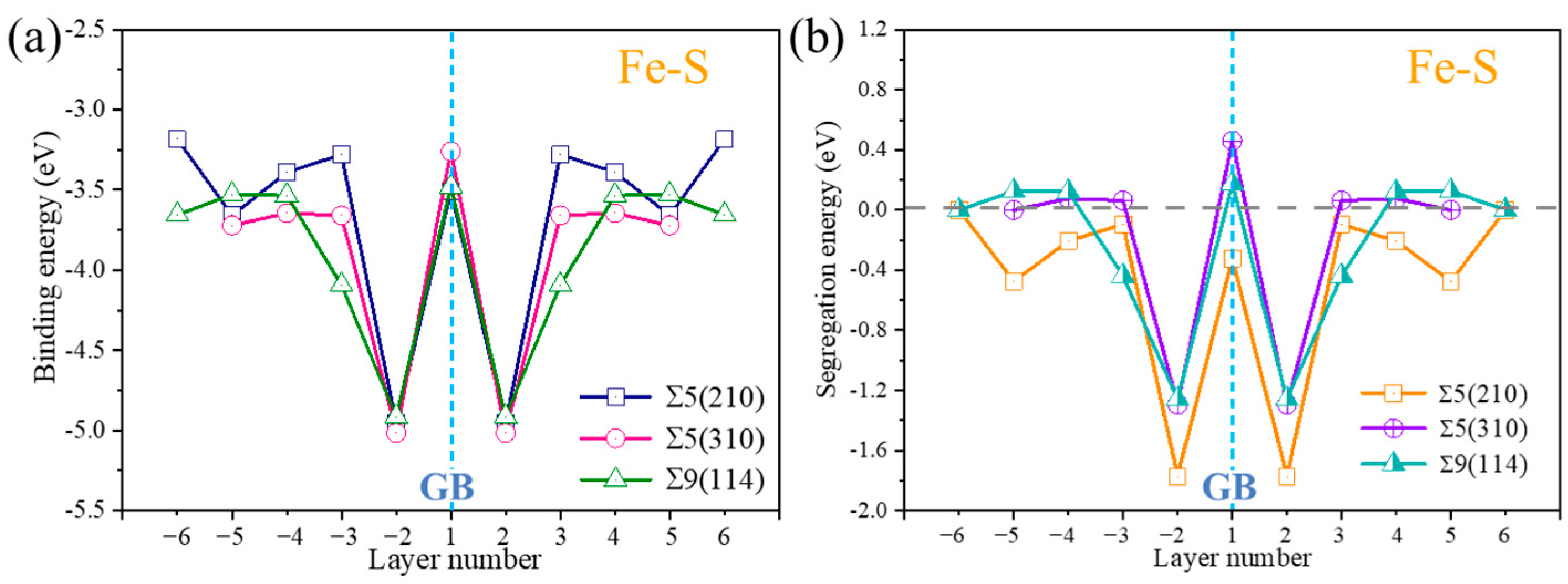
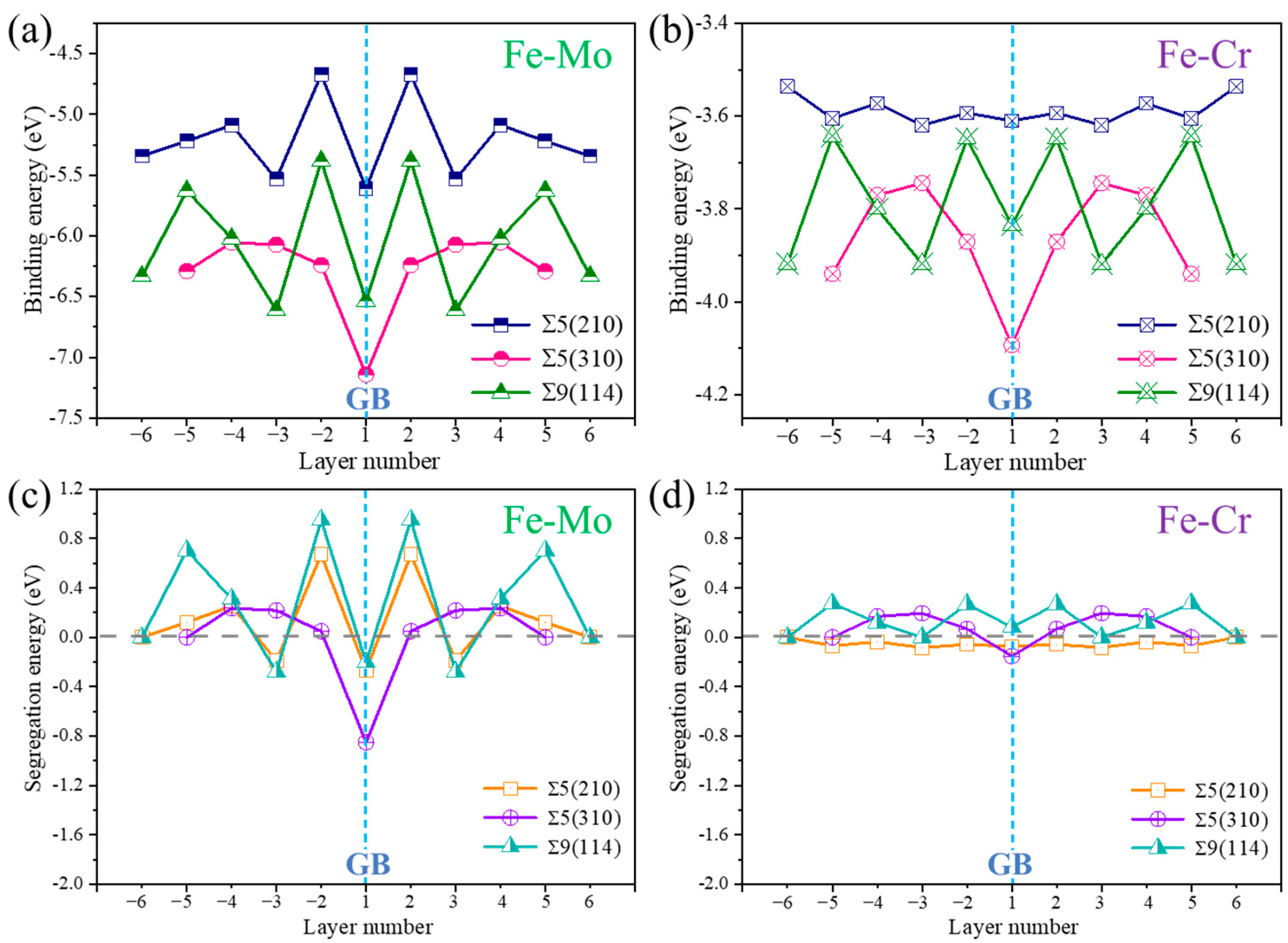
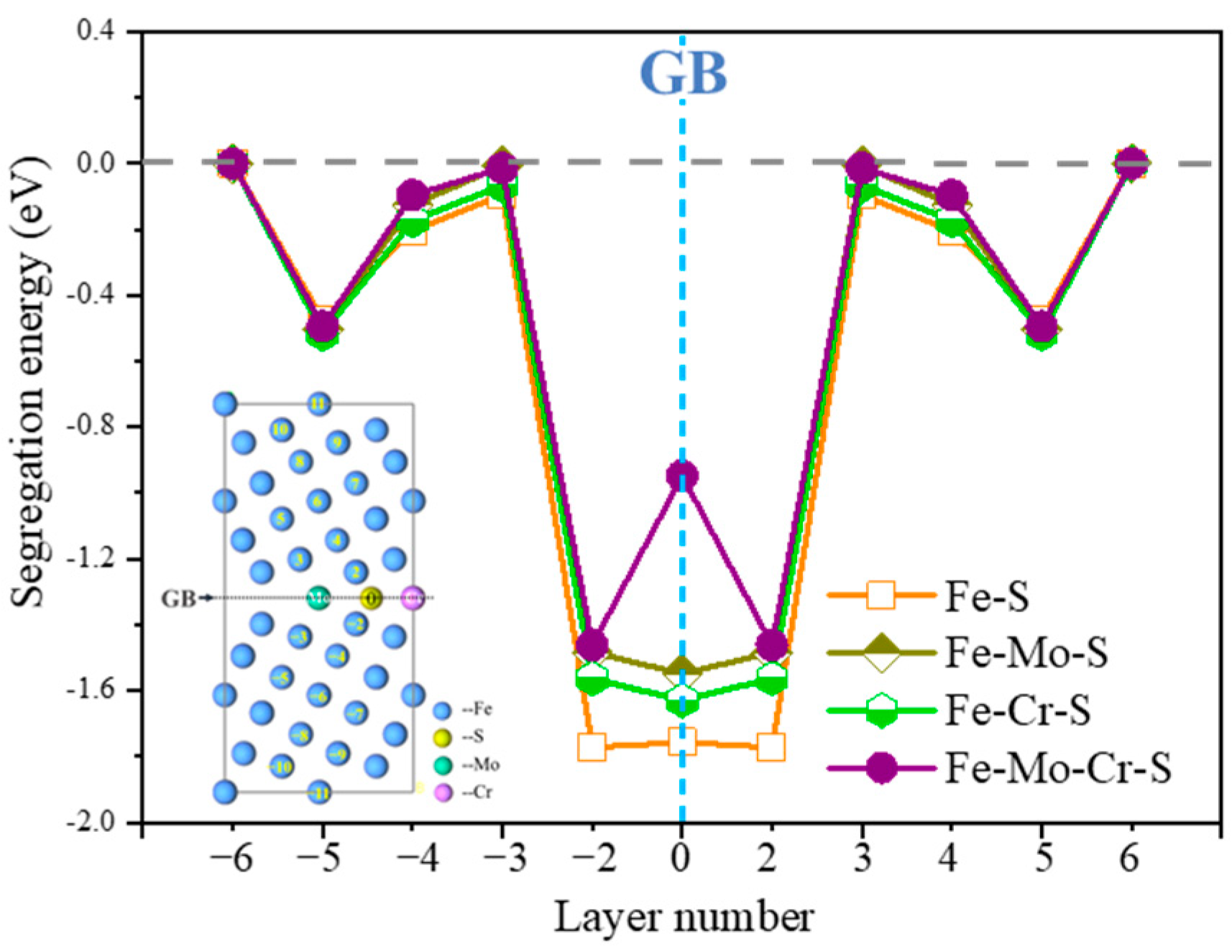

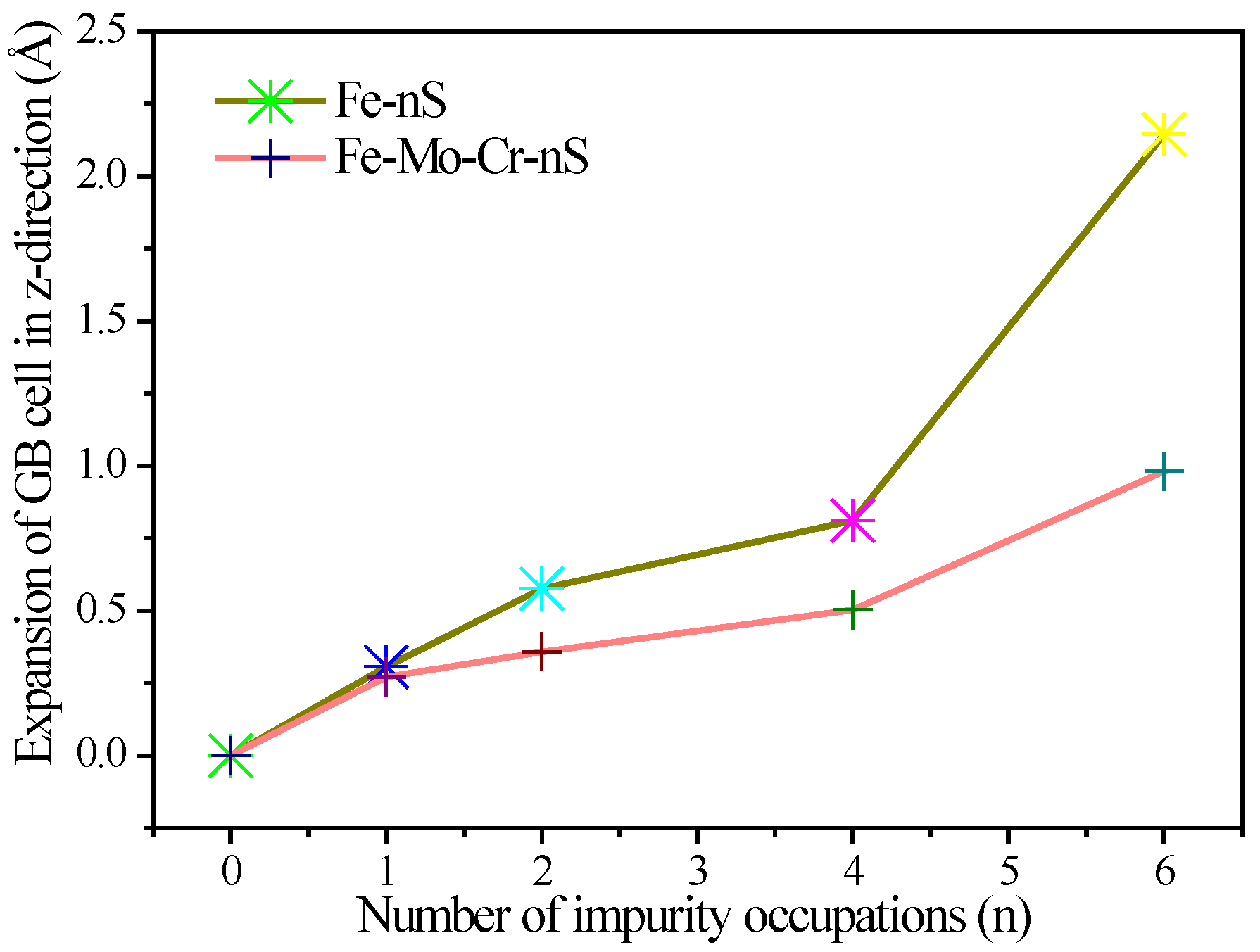
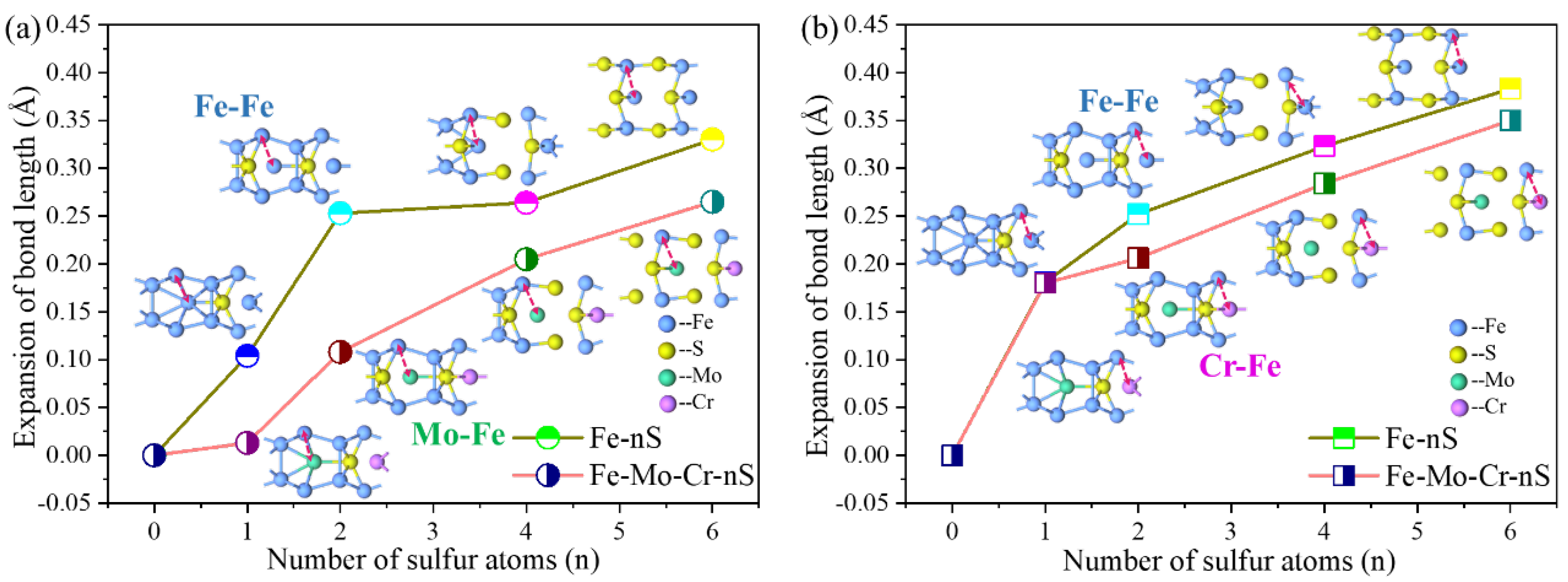
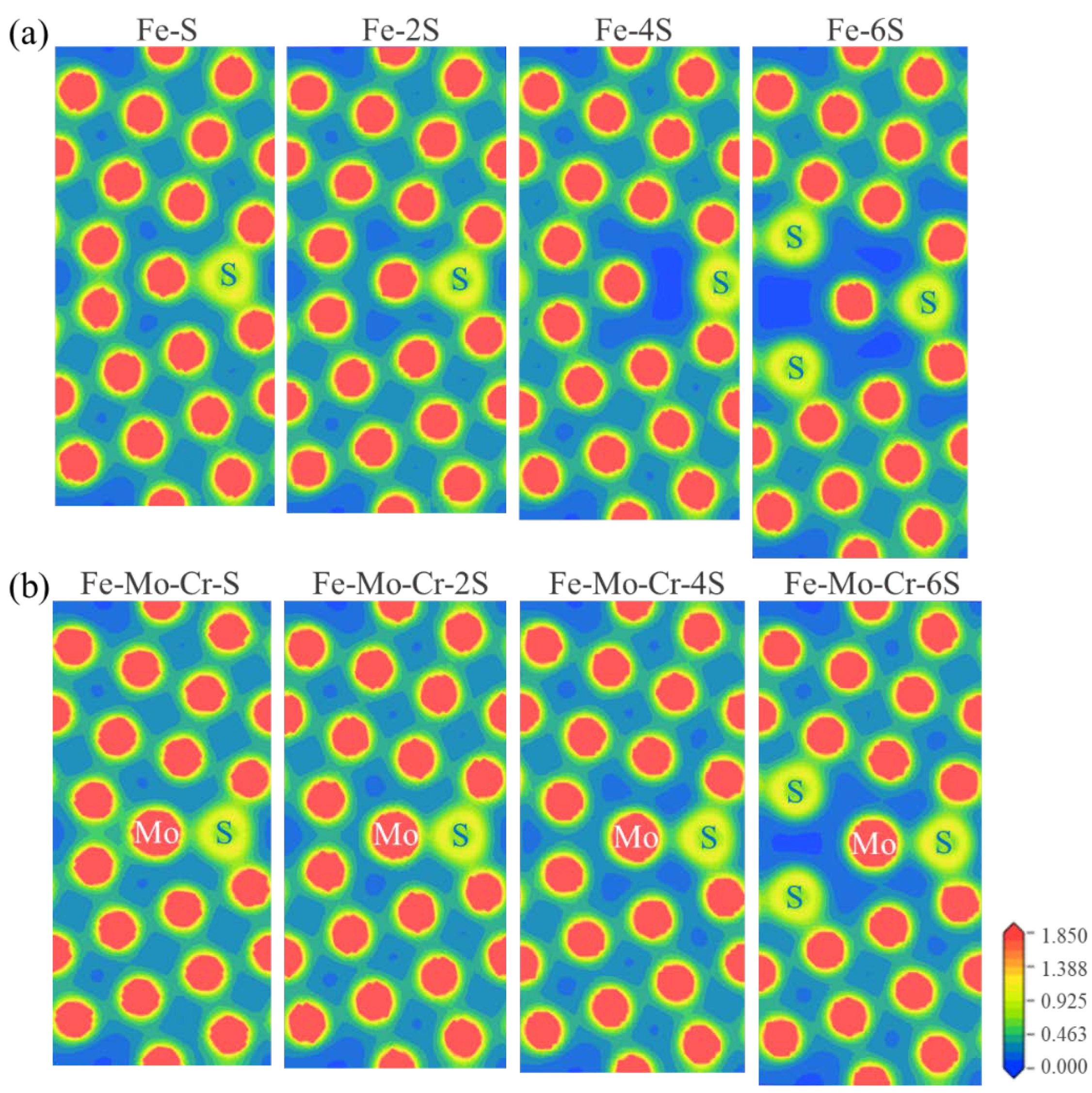
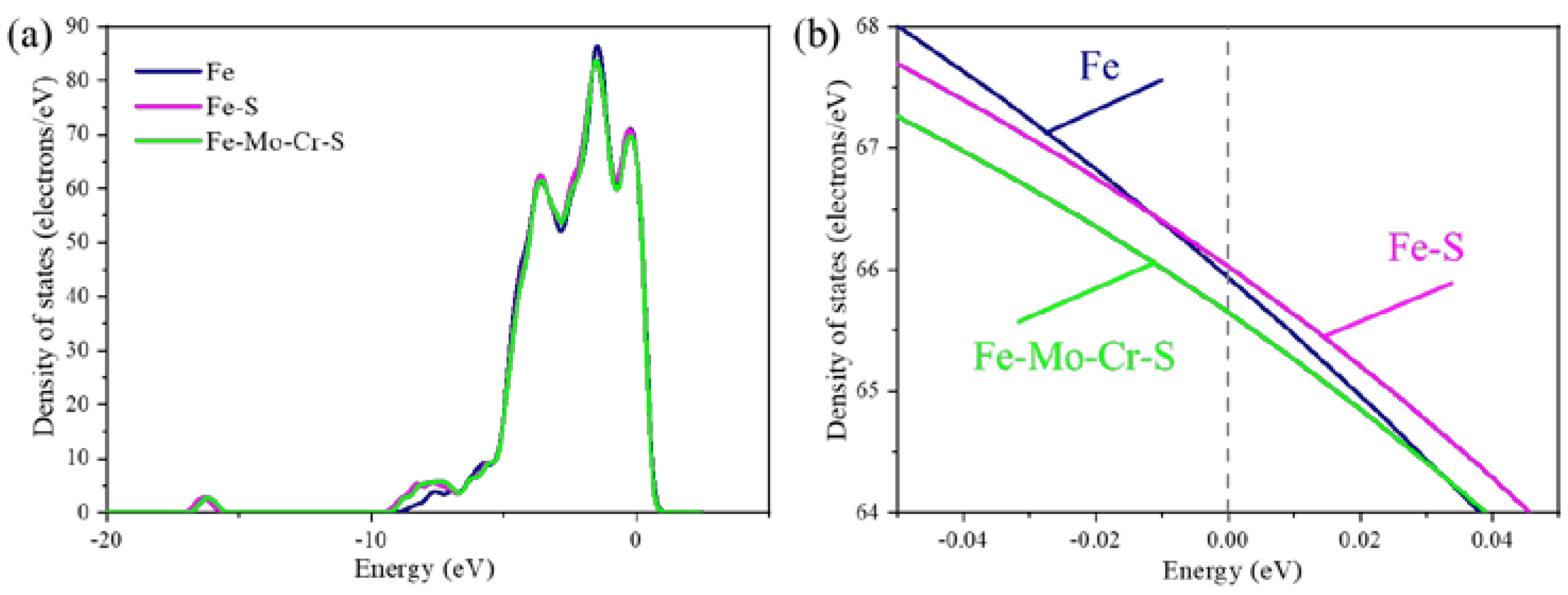
Publisher’s Note: MDPI stays neutral with regard to jurisdictional claims in published maps and institutional affiliations. |
© 2022 by the authors. Licensee MDPI, Basel, Switzerland. This article is an open access article distributed under the terms and conditions of the Creative Commons Attribution (CC BY) license (https://creativecommons.org/licenses/by/4.0/).
Share and Cite
Liu, S.; Zhang, Y.; Ren, J.; Dong, N.; Zhang, C.; Ma, J.; Jiang, Z.; Li, H.; Han, P. Effect of Mo and Cr on S-Induced Intergranular Fracture in γ-Fe. Metals 2022, 12, 1606. https://doi.org/10.3390/met12101606
Liu S, Zhang Y, Ren J, Dong N, Zhang C, Ma J, Jiang Z, Li H, Han P. Effect of Mo and Cr on S-Induced Intergranular Fracture in γ-Fe. Metals. 2022; 12(10):1606. https://doi.org/10.3390/met12101606
Chicago/Turabian StyleLiu, Si, Yi Zhang, Junyu Ren, Nan Dong, Caili Zhang, Jinyao Ma, Zhouhua Jiang, Huabing Li, and Peide Han. 2022. "Effect of Mo and Cr on S-Induced Intergranular Fracture in γ-Fe" Metals 12, no. 10: 1606. https://doi.org/10.3390/met12101606
APA StyleLiu, S., Zhang, Y., Ren, J., Dong, N., Zhang, C., Ma, J., Jiang, Z., Li, H., & Han, P. (2022). Effect of Mo and Cr on S-Induced Intergranular Fracture in γ-Fe. Metals, 12(10), 1606. https://doi.org/10.3390/met12101606






